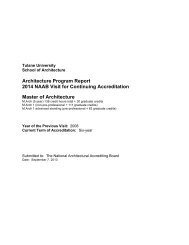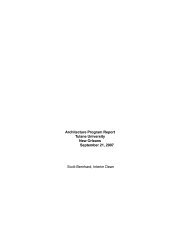NAAB Conditions for Accreditation, 2009 - Tulane School of ...
NAAB Conditions for Accreditation, 2009 - Tulane School of ...
NAAB Conditions for Accreditation, 2009 - Tulane School of ...
You also want an ePaper? Increase the reach of your titles
YUMPU automatically turns print PDFs into web optimized ePapers that Google loves.
<strong>2009</strong> <strong>Conditions</strong> <strong>for</strong> <strong>Accreditation</strong><br />
National Architectural Accrediting Board, Inc.<br />
business planning, time management, risk management, mediation and<br />
arbitration, and recognizing trends that affect practice.<br />
C. 6. Leadership: Understanding <strong>of</strong> the techniques and skills architects use to<br />
work collaboratively in the building design and construction process and<br />
on environmental, social, and aesthetic issues in their communities.<br />
C. 7. Legal Responsibilities: Understanding <strong>of</strong> the architect’s responsibility to<br />
the public and the client as determined by registration law, building codes<br />
and regulations, pr<strong>of</strong>essional service contracts, zoning and subdivision<br />
ordinances, environmental regulation, and historic preservation and<br />
accessibility laws.<br />
C. 8. Ethics and Pr<strong>of</strong>essional Judgment: Understanding <strong>of</strong> the ethical issues<br />
involved in the <strong>for</strong>mation <strong>of</strong> pr<strong>of</strong>essional judgment regarding social,<br />
political and cultural issues in architectural design and practice.<br />
C.9. Community and Social Responsibility: Understanding <strong>of</strong> the architect’s<br />
responsibility to work in the public interest, to respect historic resources,<br />
and to improve the quality <strong>of</strong> life <strong>for</strong> local and global neighbors<br />
The APR must include:<br />
A brief, narrative or graphic overview <strong>of</strong> the curricular goals and content <strong>for</strong> each<br />
accredited degree program <strong>of</strong>fered or each track <strong>for</strong> meeting the requirements <strong>of</strong><br />
the pr<strong>of</strong>essional degree program.<br />
A matrix <strong>for</strong> each accredited degree program <strong>of</strong>fered or each track <strong>for</strong> meeting the<br />
requirements <strong>of</strong> the pr<strong>of</strong>essional degree program, that identifies each required<br />
course with the SPC it fulfills.<br />
o Where appropriate, the top section <strong>of</strong> the matrix should indicate those<br />
SPCs expected to have been met in preparatory or pre-pr<strong>of</strong>essional<br />
education prior to admission to the <strong>NAAB</strong>-accredited program (see also<br />
Part II, Section 3).<br />
o The bottom section <strong>of</strong> the matrix should include only criteria that are<br />
demonstrated in the accredited degree program or track.<br />
In all cases, the program must highlight only the 1-2 cells on the matrix that point to<br />
the greatest evidence <strong>of</strong> student achievement.(For a sample matrix, see Appendix 4)<br />
[NOTE: Elective courses are not to be included on the matrix.]<br />
25














